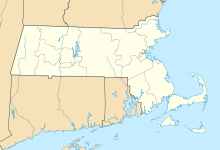Higgins Armory Museum
 |
|
| Established | January 1931 |
|---|---|
| Dissolved | 31 December 2013 |
| Location | Worcester, Massachusetts, USA |
| Coordinates | 42°17′50″N 71°47′57″W / 42.297222°N 71.799167°W |
| Type | arms and armor museum |
| Accreditation | American Alliance of Museums |
| Key holdings | 24 full suits of armor |
| Collection size | 2,000 objects |
| Visitors | 60,000 (2012) |
| Director | Suzanne W. Maas |
| Website | www |
|
Higgins Armory Museum
|
|

Higgins Armory Museum
|
|
| Location | 100 Barber Ave., Worcester, Massachusetts |
|---|---|
| Area | 20,000 sq. ft. |
| Built | 1930 |
| Architect | Leland,Joseph D. |
| Architectural style | International Style |
| MPS | Worcester MRA |
| NRHP Reference # | 80000514 |
| Added to NRHP | March 05, 1980 |
The Higgins Armory Museum was a non-profit museum, located in Worcester, Massachusetts, dedicated to the display of arms and armor. According to the Boston Globe, from its founding in 1931 until 2004 it was "the only museum in the country devoted solely to arms and armor," and had the second largest arms and armor collection in the country behind the Metropolitan Museum of Art in New York City. The collection consisted of 2,000 objects, including 24 full suits of armor. The museum closed at the end of 2013 due to a lack of funding. Its collection and endowment were transferred and integrated into the Worcester Art Museum, with the collection to be shown in a new gallery slated to open in 2015. The Higgins Armory building was sold in December 2014. The historic structure is believed to be one of, if not the first, building in the U.S. constructed solely out of steel and glass.
John Woodman Higgins was a prominent industrialist in Worcester, Massachusetts who owned the Worcester Pressed Steel Company. Higgins traveled to Europe multiple times throughout the 1920s where he collected arms, armor, and other steel items. One of his most important purchases was eight full suits of armor from the collection of George Jay Gould in 1927. Originally, he stored these items in his house, which quickly filled with anything he could find made of steel, from suits of armor to automatic shoe polishers. Higgins incorporated his collection as a museum in 1928, and as the collection grew larger than Higgins' house could hold, he began construction on a steel and glass museum building next to his factory in 1929.
"The Museum of Steel and Armor" opened on January 12, 1931, with a grand gala. Music was played by members of the Boston Symphony Orchestra and Higgins' sons dressed in suits of armor. In its original layout, the museum displayed a wide variety of objects constructed of steel including "medieval weaponry, automobile parts, and even ... an all-steel airplane suspended from its ceiling." Admission to the museum began with a walk through the armor exhibits and ended with a tour through the production lines to see modern steel manufacturing. The production floor was accessed through catwalks connecting the factory and the armory. Higgins invited visitors to the museum across these catwalks, and he also invited his workers to visit the museum on breaks to get inspired. Higgins died in 1961, leaving the museum a US$17,000 endowment. The museum was first accredited in 1972 by the American Association of Museums and continued operations through the closing of the Worcester Pressed Steel Company in 1975. On January 4, 1978 the museum was the victim of a theft of arms and armor worth over US$100,000.
...
Wikipedia

